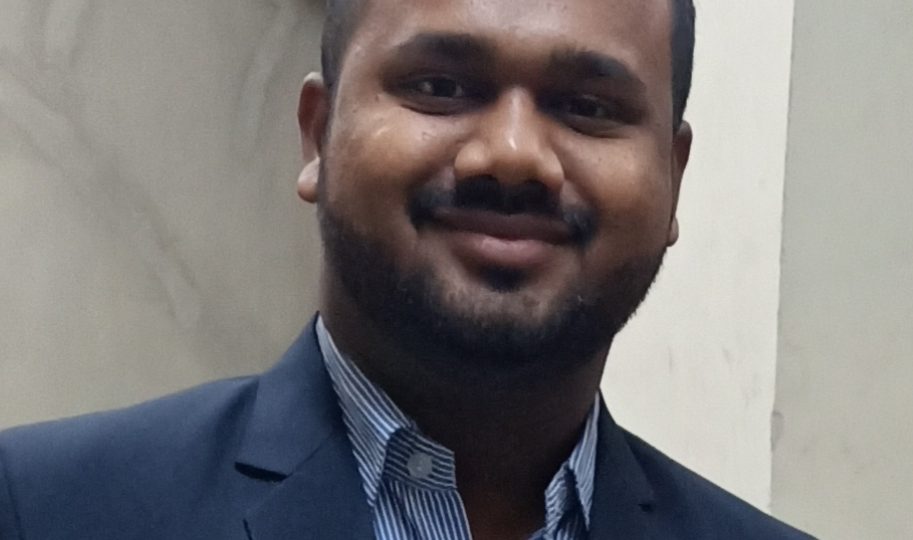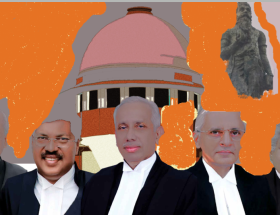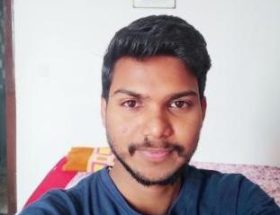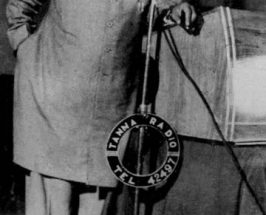Vinay D Damodar
Introduction
All over India, the working of party politics bears a marked influence exercised by the caste factor. Even left parties (witness Kerala) have not escaped from the prevailing socio-political atmosphere. In Karnataka, as in several other states, the tussle for political power has evolved on clear lines. Karnataka Assembly Election is due in next two months. The political parties have started steering the caste-religion dynamics in the state. While a large vote share is held by the Vokkaliga community in the state, the Lingayat community too is the most important community to tap during the elections.
Sometime ago, in Bidar, around 50,000 people from the Lingayat community turned up to demand a separate religious status. Since then, the number of people supporting the cause has increased. People across party lines are supporting this demand.
In this paper, we are going to look at the movement by the Lingayat community in Karnataka demanding a separate religious minority status. The main focus is to understand the debate around the caste and political factors around the movement for a separate religious minority status by the Lingayat community. The paper is divided into some parts: the first part is on who are the Lingayats; the secondly dwells on how Lingayatism is different from Hinduism, what is the demand of the Lingayat community, Lingayats as a dominant community in Karnataka, the Lingayat movement and caste politics in Karnataka elections. And lastly, the concluding remarks.
Who are the Lingayats?
A 12th century social reformist, poet, statesman and philosopher Basaveshwara is regarded as the father of Lingatayatism, as he laid down the foundation of Lingayatism. While there exists a debate around whether Basaveshwara founded the sect or if he merely reformed an existing order, there is no doubt that under him the community acquired the form of a well-organized, structured mass movement. Followers of the sect continue to revere him as the founder and prime philosopher of their religion. There are claims that Basaveshwara, also known as Basava, was born in a Brahmin family when King Bijjala I of the Kalachuri dynasty reigned in Karnataka. Basaveshwara advocated devotional practices rather than the traditional rituals like going to temples and idol worship. He stressed more on the idea of ‘Ishta Lingaa’ which implied worshipping Shiva on an individual basis by wearing symbols like a small linga.
A person following Lingayathism must follow the vachanas of Basaveshwara. It is believed that Lingayatism had in the 12th century advocated the most progressive and egalitarian values such as gender and social equality. Basaveshwara even opposed the discriminatory practice of wearing a sacred thread by the Brahmins and instead advocated the ritual of wearing Ishtalinga necklace by every person regardless of his or her birth, to be a constant reminder of one’s bhakti to Shiva.
Basavanna’s vision of a societal order was based on human freedom, equality, rationality, and brotherhood. He and his followers spread their ideas through vachanas (prose-lyrics) and their prime target was caste hierarchy which they rejected with full force. In one of his vachanas, Basavanna asserts that “the birthless have no caste distinctions, no ritual pollution.” He rejected the Brahmanical ritualism and its adherence to sacred texts like the Vedas.
Some famous personalities in Karnataka who are also followers of the Lingayat tradition include former chief minister B.S. Yeddyurappa, journalist Gauri Lankesh, and scholar M.M. Kalburgi.
How is Lingayatism different from Hinduism?
The major reason why some Lingayat community members argue that it is different from that of Hinduism is its gender neutral, caste-neutral treatment of equality. Basavanna’s reformist Bhakti movement rejected the caste system which is considered one of the integral practices of Hinduism. As mentioned earlier, Basavanna asserts that “the birthless have no caste distinctions, no ritual pollution.”
While Hinduism converted occupations into castes, Basava reversed this, turning castes into occupations again. Hindu society differentiated people based on birth while Basava offered equal status to all.
Those who argue in favor of Lingayatism as a separate religion hold it as a monotheistic practice that does not believe in forms of God but only worships the omniscient God. It also rejects practices such as Homa, Yagna, and Sacrifice and does not consider any place or any river as holy.
According to one article in Indian Express dated 14th December 2017, the issue of the Lingayats is further complicated by the fact that underneath the socio-cultural demand for a separate religion is a burning political struggle for votes. Speaking about the gradual politicisation of the Lingayat agitation in the last few decades, historian Manu Devadevan says “the movement took off in the early twentieth century. In the late nineteenth century when the first census took place, most of the communities in India started identifying themselves as homogenous groups. So to a large extent, it was a cultural movement then. You don’t find anything explicitly political there. That happens only after the 1980s.”
This whole agitation, however, revolves around a single core question: who are the Lingayats and what precisely is their religious identity?
How are they considered separate from the Hindu fold?
The emergence of the Lingayat sect can be located within the larger trend of the protest or dissent movements miscategorised as ‘Bhakti movements’ that had swept across South India from the 8th century AD onwards.
The Bhakti tradition was a social reform movement that developed around Hindu Gods and Goddesses but split away from the Hindu fold by offering a path to spirituality regardless of caste and creed. In a way, they were movements that took birth within Hinduism but strove to rectify what the followers saw as the unjust practices within the tradition. In that sense, none of the Bhakti movements could acquire the status of a separate religion as they strived to improve the religion within which they were born.
However, the case of the Lingayats was different. While they also fell into the category of a social reform movement within Hinduism, they made some radical departures from the traditional Bhakti paradigm. “While the conventional Bhakti movements were marginally, vaguely and emotionally critical of the existing Brahmanical Hindu system, Lingayatism challenged it to its roots, and made good its challenge by becoming a highly structured movement, striving for the institutionalization of the same or similar values professed by the Bhakti movements in general,”
“The Lingayat Bhakti movement in Karnataka assumes the form of a cult in itself. From very early times, the Lingayat status was hereditary in nature. This is something that did not happen within the Bhakti movements elsewhere in South India, which is why they are demanding a separate religious status,” says Devadevan. Therefore, Basavanna’s movement did not just uproot the Hindu cultural practices but also broke away from the other Bhakti movements by forming an institutionalized order for themselves.
How are they considered a part of the Hindu fold?
What complicates the issue, however, is that while Lingayatism breaks away from the larger Hindu fabric in significant ways, it also assimilates large portions of it, thereby making their identity difficult to define. The one aspect that strengthens its association with Hinduism is the relationship the faith shares with Veerashaivism.
While it is popularly believed that Lingayatism and Veerashaivism are one and the same, historical evidence suggests that they are not.
Basavanna offered an alternative model. The Veerashaivas claim mythical origins from the Shivalingam, which is similar in thought to the origin theories of Brahmanism. Basavanna, on the contrary, opposed all Brahmanical roots. However, the debate surrounding on whether Basavanna founded the Lingayat sect or simply modified the already existing Veerashaivism sect makes it difficult to discern to what extent they can be considered separate from the Hindu traditional framework.
The complications also arise from the fact that Lingayatism, while rejecting large portions of the Hindu traditional practices, does assimilate some aspects of it, just like it absorbs aspects of other contemporary religious traditions like Jainism and Vaishnavism. “These are influenced by the Upanishads, Jain and Vaishnava traditions. They have drawn from Vedic traditions,” says Devadevan. The close associations that the Lingayat followers share with Hinduism, both sociologically and historically, make it a complicated case of to be or not be Hindu.
What is the demand of the Lingayat Community?
In March 2018, a group of Lingayat seers met Karnataka Chief Minister Siddaramaiah and urged him to implement the report of an official committee that recommended conferring a separate religious and minority status to their community. The seers led by Gadag-based Tontadarya Mut’s Siddalinga Swami, called on Siddaramaiah at his official residence and wanted him to consider and implement the Nagmohan Das Committee’s report which has said “Lingayats in Karnataka may be considered as a religious minority”.
According to Tontadarya Mutt Swami, their fight is not new, it has been a 900 year old fight and it has taken a shape now. Therefore, the Chief Minister should implement the report and accord separate status to the Lingayat community.
The demand for a separate religious tag to Veerashaiva/Lingayat faiths has surfaced from numerically strong and politically influential communities, amidst resentment from within over projecting the two communities as the same.
One section is led by the Akhila Bharata Veerashaiva Mahasabha which has demanded a separate religious status, asserting that Veerashaiva and Lingayats are the same. The other wants the status only for Lingayats as it believes that Veerashaivas are one among the seven sects of Shaivism, which is part of Hinduism.
Lingayat leader Mate Mahadevi, who also spoke, expressed confidence that Siddaramaiah would meet their demand and recommend to the centre to grant a separate religious minority status to their community. The demand of Lingayat seers came shortly after Veerashaiva pontiffs had expressed their displeasure over the report as it excluded the Veerashaivas.
In short, the Lingayat community is demanding the status of a religious minority and if the Veerashaivas want to be included, then they should leave Hinduism and follow Lingayatism.
Lingayat movement and Caste Politics in Karnataka elections
The observers of Karnataka elections are familiar that the caste based political dynamics are deep-rooted in the state. The Lingayat movement goes far beyond the religious and social construct. One might be too imprudent to believe that the demand for a separate religion is only about gaining recognition for a religious identity.
According to James Manor (1997), politics in Karnataka has for long been characterized by a sea-saw struggle between two dominant communities – Lingayats and the Vokkaligas. Things, however, have been changing, and the changes have been most pronounced during the regime of Devaraj Urs. Certain deliberate (and occasionally crude) measures adopted by the Urs regime have been instrumental in undercutting the role of these traditional power centers. The result has been the emergence into political prominence of a grouping which had suffered from both Vokkaliga and Lingayat oppression.
Karnataka offers a classic case of stable, Congress party dominance for decades. The Congress has won 129 of the 145 Lok Sabha seats contested in general elections since 1932 and it has never lost a by-election. The party has always controlled the state assembly with very comfortable majorities, apart from a brief break at the time of the Congress split. The Congress has held sway in municipal and local board politics in a similar fashion. Political rivalries in Karnataka have tended to occur within the Congress rather than between the Congress and other parties.
The people who worked for and benefited from the Congress system at all levels were drawn predominantly from the two -so-called dominant ‘castes’ of the state, the Vokkaligas and the Lingayats.
Although they are often referred to as ‘majority communities’, Lingayats and Vokkaligas together constitute only about a third of the population of the state, according to some claims. A Congress dominated by these groups could nonetheless count on a sufficient number of votes from other groups to be sure of sizable electoral majorities. The party relied upon the leverage which Vokkaligas and Lingayats derived from land control and key positions in the villages. It also carefully cultivated ties with select leaders of other social groups to be able to contain the grievances of these excluded and dominated sections of society.
In Karnataka alone, Lingayats are one of the dominant communities, when it comes to voting shares. The demand for separate religious status is only motivated by the benefits that come with having a minority status. Reservation is one of them.
The BJP has a heavyweight Lingayat leader, B. S. Yeddyurappa, heading the party in Karnataka. He is also the CM face of the party. However, the party’s main ideology being Hindutva, it has never supported or will never support the movement.
Even Yeddyurappa himself distanced himself from the movement.
On the other hand, Congress has decided to take the risk of supporting the demand for a separate religion status to the Lingayat community. Traditionally, Lingayats have kept a distance from Congress; so it may seem that supporting the demand may attract a vote bank.
Karnataka Chief Minister Siddaramaiah even told the community that Congress is ready to represent their concerns to the central government.
Now whether the Lingayat community vote falls in Congress’ favour or helps the BJP to further consolidate the Hindu votes, is to be seen.
Lingayat Community
Dynamics of Indian state politics cannot be understood without the study of dominant castes/communities because they are numerically, socially, economically, educationally and politically dominant. The Lingayats and the Vokkaligas are two such dominant communities/castes in Karnataka state politics.
Prof. M. N. Srinivas, sociologist, in his book, The Dominant Caste and Other Essays, describes the characteristics of a dominant caste in this way :
“A caste may be said to be dominant when it preponderates numerically over other castes and when it also wields preponderant economic and political power”. He further added social status and occupation to the components of dominance. He opines that a dominant caste has a multiplier effect and thus says: “When a caste enjoys one form of dominance, it is frequently able to acquire the other forms as well in course of time”.
He identifies finally six components/elements of a dominant caste/community. These are (i) numerical strength, (ii) economic power, (iii) higher social status, (iv) better education, (v) status of occupation, and (vi) political power. Louis Dumont also talks of more or less the same attributes of a dominant caste when he refers to the Nayar caste in Kerala.
The Lingayat community is divided occupationally into five groups – priestly, trading/commercial, agriculture, and artisan and miscellaneous. A vast majority is engaged in agriculture; their second major occupation is business and rest of them are engaged in miscellaneous work. All the Lingayat dominated villages, towns and cities have the monasteries of the priestly class. The Lingayat monasteries are the biggest in number among all monasteries in Karnataka. Many of them run free boarding for poor Lingayat students, have established several educational institutions and been publishing Veerashaiva/Lingayat literature.
Though the Lingayats are generally well placed in terms of ownership of land and business, there are a sizable number of poor people among them.
The Lingayats are one of the numerically dominant communities in Karnataka and are found in small numbers in other southern states like Telangana, Maharashtra, Andhra, Tamil Nadu and Kerala.
The agents of modernisation like rapid transport and communications, western liberal education, printing press, newspapers, industrialisation, urbanization, etc., and introduction of democratic processes like spread of democratic ideas and literature and establishment of democratic institutions in the 19th century in India created new awareness among Indians including the Lingayats. The Lingayats took the advantage of the agents of modernisation and spread of democratic institutions to develop their community on a modern basis. They wanted to compete with the Brahmins in this respect and to prove that they are second to none.
The Lingayat community, which is also dominant in the traditional society, has made use of the agents of modernisation and democratic institutions, and retained its relative dominance under the changed conditions. As Prof. Srinivas has pointed out, as a result of the multiplier effect of dominance in one field spreading to another field, Lingayat community has the benefit of dominance in various fields including politics. In the absence of other competitors, the Lingayat-Vokkaliga informal alliance was able to establish unquestioned dominance in the state politics of Karnataka between 1 956 and 1 972. With the emphasis on empowerment of the weaker sections by the Congress between 1972 and 1983, the Congress was able to reduce the dominance of the Lingayat-Vokkaliga alliance in the state politics of Karnataka. As politically, socially awakened and economically empowered weaker sections became assertive in state politics, the Lingayat-Vokkaliga informal alliance has now become only an alternative competitor and not an exclusive player in Karnataka state politics.
Conclusion
The Lingayat community in Karnataka demanding a religious minority status, finds themselves different from Hinduism. The Karnataka State Cabinet gave their approval to the recommendation of Nagmohan Das Panel report which says that Lingayats should get the religious minority status. Now only the centre should give approval to it. I find this movement of Lingayat community for a separate religious minority status, is in some way similar to the movement by the Maratha community in Maharashtra demanding reservation for the community. Marathas are a dominant caste and politically predominant in Maharashtra. There is good representation of Maratha community in state politics, with a strong presence across parties. And la few years ago, the Congress approved their demand for reservations, similar to the Lingayat demand in Karnataka, when they were in power and the assembly elections were due. But this demand was rejected by the Supreme Court.
Now, here in Karnataka, the case is the same: the Congress approved the Lingayat demand in the state assembly before the elections. But it can be challenged in the Court, as some people from Veershaivas and BJP are in opposition to it claiming that it is dividing the community. The only difference is that Lingayaism is different and what makes it unique is that they are people who had followed the philosophy of Basavanna, which rejects the caste hierarchy and Hinduism. And because of that it can be given a religious minority status. Finally, if it gets the religious minority status it is going to have a great impact on caste politics and governance in India.
~
References
Manor, J. (1977). Structural changes in Karnataka politics. Economic and Political Weekly, 1865-1869.
Patil, S. H. (2007). Impact of modernisation and democratisation on a dominant community: A case study of the Lingayat community in Karnataka. The Indian Journal of Political Science, 665-684.
Ray, A., & Kumpatla, J. (1987). Zilla Parishad Presidents in Karnataka: Their Social Background and Implications for Development. Economic and Political Weekly, 1825-1830.
https://www.thenewsminute.com/karnatakas/564
https://www.news18.com/news/india/lingayat-veerashaiva-split-wide-open-top-congress-leader-son-may-join-bjp-1695619.html
http://www.firstpost.com/politics/lingayat-seers-meet-siddaramiah-to-press-for-implementation-of-nagmohan-das-panel-report-minority-status-4395451.html
http://velivada.com/2018/03/19/the-battle-between-caste-and-anti-caste-lingayats-revolt
~~~
Vinay Damodar is an Ambedkarite research scholar currently pursuing PhD in Inclusive Development and Social Justice, from Centre for Study of Social Exclusion and Inclusive Policies, Tata Institute of Social Sciences, Mumbai. His interest lies in intersections of Caste, Anti-caste movement, the Politics of Ambedkarite groups, Dr. Ambedkar’s thoughts and vision, etc. He hails from Bhim Nagar, Akola, Maharashtra.










